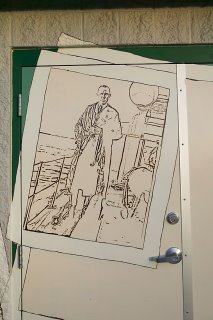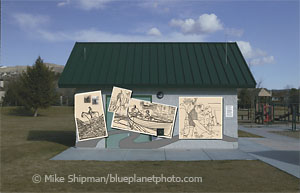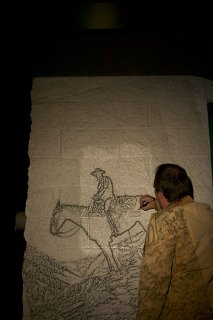
George Baggley, Isle Royale National Park, circa 1937
Today I finished the 1937 "Jacket" image of George Baggley as he stands on the deck of what appears to be a steamship, wearing a black leather trenchcoat. This photo is to the right of the "1929" photo of George on horseback, and lies on top of the "Rowboat" image described below. It took me 4.5 hours to paint the details of the "Jacket" photo after about 1.5 hours of tracing the image last night. After finishing the painting, I then traced the next image, George Baggley and daughter Ruth Ann in a rowboat, also at Isle Royale. I will paint this tomorrow (11/15), weather permitting. My concern now is with the temperature. When the paint gets cold it's like pudding. It's possible I may have to wait until spring to finish the east side. I should have the west side completed this week or early next week.

George was not the only pioneer in the family. He met his wife-to-be, Herma Albertson, at Yellowstone National Park.
Herma Albertson was born in 1896 in Inwood, Iowa, and moved to Idaho when she was very young. She attended the University of Idaho and received her Masters in Botany there. In 1929, a year after George Baggley started his tenure at Yellowstone, Herma Albertson was a seasonal ranger at Old Faithful. She returned in 1930 as a seasonal, and in 1931 became the first female permanent ranger naturalist at Yellowstone National Park.
Herma Albertson beside antler house in front of Mammoth Museum (visitor center), Yellowstone National Park (courtesy NPS Archives)Herma Albertson Baggley co-authored a field guide,
The Plants of Yellowstone National Park, with W.B. McDougall, in 1936. It was revised in 1956 and is still relevant and in use today as well as a desired collector's item. She also developed nature trails at Yellowstone which were models for the rest of the National Parks.
In 1952, Herma was the leader of the National Park Women, an organization formed in that year within the National Park Service to address housing issues. The organization still exists today and is active at the area, regional and national levels. Still involved with housing issues, the organization is also involved in scholarships, welcome and orientation, information sharing, scientific concerns, communication, and hospitality.
Herma Albertson Baggley was a pioneer in her field and was dedicated to breaking ground for women in a male-dominated workplace and society. The University of Idaho awards the Herma Albertson Botany Scholarship to undergraduates majoring in Biological Sciences.















